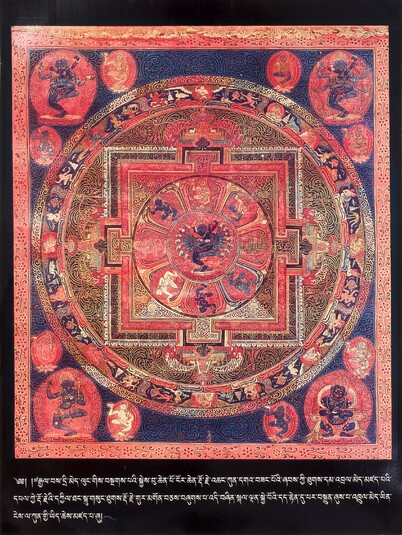
Item: Mandala of Hevajra (Buddhist Deity) - (Hevajra Tantra)
| Origin Location | Tibet |
|---|---|
| Date Range | 1400 - 1499 |
| Lineages | Sakya, Ngor (Sakya) and Buddhist |
| Material | Ground Mineral Pigment on Cotton |
| Collection | Private |
Hevajra Eight Deity Mandala (Tibetan: pal gye pa dor je lha mo gye) according to the uncommon oral instruction tradition of mahasiddha Virupa and the Margapala system of Tantric practice. Within the Ngor Tradition this painting is believed to originally have belonged to Ngorchen Kunga Zangpo and remained with him as his kaya samaya when traveling.
Sanskrit: Hevajra Tibetan: Gye pa dor je
Tibetan: Gye pa dor je
Shri Hevajra is a principal meditational deity of the Anuttarayoga classification in Buddhist Tantra. According to the Sakya system Hevajra belongs to the sub-class of 'non-dual' tantra. The Kagyu system classifies Hevajra as 'Wisdom-mother' tantra. From the numerous texts within the cycle of Hevajra the root Tantra of 'Two Sections' is the most important. Bibliographic reference: Hevajra Tantraraja Nama
Lineage: Vajradhara, Vajra Nairatmya, Virupa, Kanhapa, Damarupa, Avadhutipa, Gayadhara, Drogmi Lotsawa, Seton Kunrig, Shangton Chobar, Sachen Kunga Nyingpo (1092-1158), etc.
Jeff Watt 8-2009
Numbered Image - Blue:
1. Hevajra, Sixteen-armed
2. Hevajra, Two-armed
3. Hevajra, Four-armed with Consort
4. Hevajra, Six-armed with Consort
5. Mahakala, Panjarnata
Numbered Image - Yellow: 1.
2.
3.
4.
5.
6.
7.
8.
Numbered Image - Red:
1.
2.
3.
4.
5.
6.
7.
8.
Buddhist Deity: Hevajra Mandala (Masterworks)
Subject: Why Paintings Are Made
Buddhist Deity: Hevajra Mandalas
Subject: Ngor Masterworks
Subject: Greyscale - Figurative & General Composition
Tradition: Sakya Painting & Sculpture Chronology - Dated

